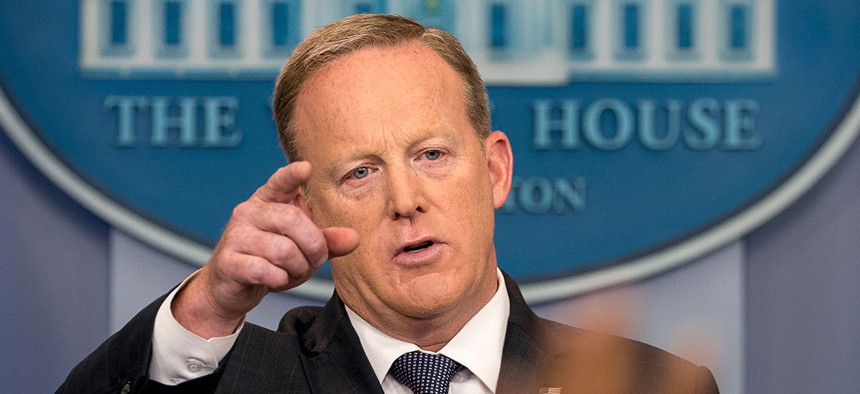
Andrew Harnik/AP
‘Covfefe’: A Typo? A Conspiracy? A Metaphor for America?
According to Sean Spicer, President Trump's garbled late-night tweet was something much more than it seemed.
“What is ‘covfefe’?”
That was the voice of a White House reporter, on Wednesday afternoon, asking a question of White House press secretary Sean Spicer on behalf of herself and many confused Americans. Her question was practical and philosophical and full of frustration: What, truly, is “covfefe”? Was it the word “coverage,” autocorrected? An errant Starbucks order? An English verb of Old Norse origin, meaning “to back out of the Paris climate accord”? A coded—pardon me, a covded—message from the Illuminati, its true meaning known only to Robert Langdon and/or the innards of a Jeffersonian codex?
Yeah, it was probably a typo. That is the simplest answer, the Occam’s razor answer. When the president sent a tweet out to his 31 million followers late on Tuesday evening—“Despite the constant negative press covfefe,” the message read in its entirety—the posting seemed the result of that most common of internet snafus: sending a thing out before the thing is ready to be sent. The president, very likely, was writing something about his negative press coverage, and mistakenly hit a wrong button, and then mistakenly hit “Tweet.” Thumbus interruptus, who among us, etc.
Trump seemed to admit to having typo-ed when, on Wednesday morning, he deleted the “covfefe” tweet and sent a teasing note in its place: “Who can figure out the true meaning of ‘covfefe’ ??? Enjoy!”
Enjoy it, of course, people had. All those jokes. All those memes. All that convfefiality. But that was Tuesday night. By Wednesday, the nation was ready to move on.
But then! On Wednesday afternoon, Spicer conducted his off-camera press conference. And the press secretary seemed to deny the Occam-y explanation of “covfefe.” According to audio of the briefing:
“Do you think people should be concerned that the president posted somewhat of an incoherent tweet last night and that it then stayed up for hours?” a reporter asked Spicer.
“Um, no,” the press secretary replied.
“Why did it stay up so long? Is no one watching this?” the reporter asked.
“I think the president and a small group of people knew exactly what he meant,” Spicer answered.
At which point chaos erupted among the press gallery. Their cries went like this, according to one transcript:
“Wait a minute!”
“What does he mean?”
“What does the president mean?”
“What is ‘covfefe’?”
“Oh, my gosh.”
With that, in a single statement made to a room of terribly confused reporters, the White House press secretary turned what appeared to be a simple typo—the kind of mistake that speaks to the direct-to-the-people communications approach that the president’s supporters so often admire in him—into … something more. An inside joke? A coded message among “the president and a small group of people?” And so “covfefe” became, in an instant … a covfspiracy theory. The Boston Globe called Spicer’s explanation “head-scratching.” The Hill called it “cryptic.” HuffPost called it “eyebrow-raising.”
What it also was, though, was unnecessary. That first reporter in Spicer’s briefing had asked a fairly straightforward question—not “what did the president mean by ‘covfefe,’” because who can know what lurks within the hearts of men, etc.—but rather “should people be concerned” that the errant tweet was left up for so long. At which point Spicer could have admitted that the tweet was a typo, and reiterated that that kind of unmediated communication is one of the president’s political assets; or excoriated the press for focusing on a single tweet when there are so many bigger stories taking place; or, indeed, explained what “covfefe,” if not a typo, actually meant.
Spicer did none of those things. He suggested that the garbled word did mean something, but then, in the same sentence, suggested that the meaning was something the press, and by extension the American public, would not be privileged to learn. He emphasized the us-versus-them ethos that has defined the Trump White House’s approach to the media. He took something simple—so achingly simple—and gave it the whiff of conspiracy. He took Occam’s razor and gave it his own spin: In his briefing room, the press secretary suggested, the most convoluted explanation of something is usually the correct one.






